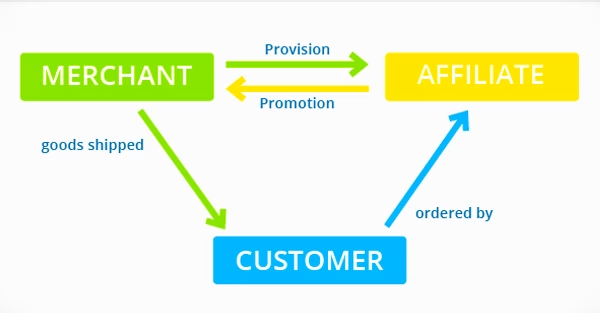Looking for the best free affiliate marketing course to start earning money online? Look no further! Discover how to go from complete beginner to profitable affiliate marketer without spending a dime.
Learn proven strategies that helped thousands of newbies and students generate passive income through affiliate commissions – all while working from home on your schedule.
We’ll demystify the entire process of affiliate marketing – from choosing profitable niches and finding high-converting products to driving targeted traffic and optimizing your campaigns for maximum earnings. Whether you’re a complete newcomer or have tried affiliate marketing before, our comprehensive free training will give you the exact blueprint successful affiliates use to earn consistent commissions.
Who Are the 3 Players in Affiliate Marketing?

- Merchants or Advertisers: These are businesses or individuals offering products or services and running an affiliate program. Examples include e-commerce stores, software companies, and online course providers.
- Affiliates or Publishers: These are individuals or entities promoting the merchant’s products and services to their audience in exchange for commissions. Affiliates often utilize websites, blogs, social media platforms, or email marketing.
- Consumers: These are the end users who take action through an affiliate’s promotional efforts, such as making a purchase or signing up for a service.
Success in affiliate marketing revolves around understanding the targeted audience and providing value through authentic recommendations. Affiliates typically use several strategies to drive traffic and conversions, including content marketing, search engine optimization (SEO), social media promotion, and email campaigns.
For beginners, selecting a suitable affiliate program is critical. Many established platforms, such as Amazon Associates, ClickBank, and ShareASale, provide a starting point for newcomers.
Taking time to research products and identify niches that align with a person’s interests and skills can significantly improve results over time.
How Affiliate Marketing Works: The Basics
Affiliate marketing operates by connecting three key parties; affiliates, merchants, and consumers through a performance-based model. The process is straightforward but involves several essential steps.
Understanding these steps can help beginners start with confidence and work toward sustainable success. Let’s see how the process flows in 5 simple steps.
1. Merchant Creates an Affiliate Program
The foundation of affiliate marketing starts with a merchant or business that creates a program to promote their products or services. Merchants typically use affiliate networks or custom platforms to set up tracking, commissions, and promotional materials.
These tools ensure affiliates have the resources to effectively drive results.
2. Affiliate Joins the Program
Individuals or businesses, known as affiliates, sign up for the program. Affiliates often register through networks like Amazon Associates, PartnerStack, Impact, Partnerize, ShareASale, or ClickBank among others.
They must read and agree to the merchants’ terms and conditions before beginning promotion. Registration may include receiving an affiliate tracking link or unique promo codes.
3. Promotional Strategies Are Implemented
Affiliates promote the merchants’ products or services using their preferred marketing channels. These channels may include blogs, social media platforms, email campaigns, or YouTube reviews. By embedding affiliate links in content, affiliates direct potential customers to the merchant’s site while tracking activity.
4. Consumer Clicks and Purchases
When a consumer clicks the affiliate link, they are redirected to the merchant’s page. If the consumer completes a specific action such as purchasing a product, this is tracked through cookies or affiliate ID systems.
The tracking ensures the sale is credited correctly to the affiliate.
5. Affiliate Earns a Commission
After a successful transaction, the merchant pays a predetermined commission to the affiliate. Payments are usually made based on milestones or schedules, such as monthly payouts, and are calculated as a percentage of sales or a flat fee per action.
Affiliate marketing thrives thanks to its win-win structure, benefiting all participants while leveraging transparency and scalability.
Choosing the Right Affiliate Programs

Selecting the ideal affiliate programs is a critical step in building a successful affiliate marketing business. Not all affiliate programs are created equal, and choosing the wrong one can result in wasted effort and minimal returns. To maximize earnings, beginners must evaluate programs based on multiple key factors.
Explore the Best Software Affiliate Programs for Beginners
One of the most important considerations is product-market fit. Promoting products that align with the target audience’s needs and interests yields better conversions. Affiliates should identify their niche and select programs offering high-quality products relevant to that niche. Relevance directly impacts trust and engagement, which are essential drivers of affiliate success.
How Much?
Commission structure is another critical aspect to assess. Some programs offer flat-percentage commissions, while others have tiered systems or recurring commissions for subscription-based products. It’s essential to choose a program with competitive payouts that reflect the value of the effort invested.
High-ticket or recurring-commission programs often provide better long-term income potential.

Affiliates also need to look into the program’s cookie duration. The cookie duration determines how long they are credited for a referred sale after a user clicks on their link. Longer cookie durations, such as 30 days or more, provide more opportunities to earn commissions if the buyer doesn’t make an immediate purchase.
The credibility of the affiliate program and the vendor is equally vital. Affiliates should partner with programs that have a trustworthy reputation and reliable payment systems. It’s beneficial to research user reviews and testimonials before signing up.
Transparent tracking and reporting tools also matter as they help affiliates monitor performance and optimize strategies.
Another key factor is support. New affiliates may require additional guidance when starting. Programs offering educational resources, dedicated account managers, or active community forums provide added value and can accelerate success.
Finally, evaluating market competition is essential. For beginners, entering oversaturated programs may be challenging. Instead, selecting programs with moderate competition in emerging or unique markets could yield higher rewards over time.
How to Build an Affiliate Website
Creating an affiliate marketing website designed for long-term success is fundamentally about establishing a solid foundation. A well-crafted site should act as a hub for delivering valuable content, engaging your target audience, and building trust.
Choosing a niche is critical, as it determines the direction of your site and the type of audience you’ll attract. It’s essential to select a niche that balances your personal interests, market demand, and profitability.
UX Commandments
The website’s structure and design play a significant role in its success. A clean, user-friendly layout ensures visitors can easily navigate your content. Integrating responsive design ensures the site is accessible across devices, catering to the growing number of users on mobile platforms.

A focus on fast loading times and intuitive menus further enhances user experience, encouraging visitors to stay longer on your site.
Quality content is the lifeblood of an affiliate marketing website. Publishing articles, reviews, and guides that solve your audience’s problems fosters trust and positions the site as an authority.
Incorporating search engine optimization (SEO) strategies is vital to improving your site’s visibility on search engines. Use relevant keywords naturally and create headings, meta descriptions, and URLs optimized for search. This ensures your content reaches the right audience.
Once the site is live, tracking and analyzing results is key to refining your approach. Utilize tools like Google Analytics to monitor traffic, identify top-performing content, and adjust strategies. Building an email list is another strategic move for nurturing relationships and driving repeat visits.
A consistent, value-driven approach ensures your affiliate marketing website evolves alongside your audience’s needs, paving the way for sustainable success.
Traffic Strategies: Attracting Visitors to Your Links
Generating consistent, targeted traffic is essential for affiliate marketing success. Without visitors clicking on your affiliate links, earning commissions becomes challenging.

The key lies in strategies that effectively attract those who are interested in the products or services being promoted.
Below are proven traffic-generation methods tailored to beginners in affiliate marketing.
1. Leverage Search Engine Optimization (SEO)
SEO is one of the most cost-effective ways to drive organic traffic. By creating content that targets low-competition keywords related to your niche, you can rank higher on search engine results pages (SERPs). Optimizing for user intent, using internal and external links, and ensuring mobile-friendly content are critical.
Tools such as Mangools KWFinder, Google Keyword Planner, and SEMrush help identify keywords with good traffic potential.
Find the Perfect Keywords: Try the Best Research Tools Now!
2. Utilize Social Media Platforms
Social media channels, like Instagram, Pinterest, and Facebook, offer a platform to connect with a targeted audience. Compelling visuals, engaging posts, and regular interactions help build trust and drive clicks.
For beginners, focusing on one or two platforms aligned with their audience’s demographics ensures better results. #Hashtags, trending content, and collaborations can expand reach without incurring advertising costs.
Turn your social media into a traffic-driving powerhouse for your blog!
3. Create High-Value Blog Content
A blog serves as both an informational hub and a traffic magnet. Writing tutorials, reviews, and comparison articles related to your niche establishes authority and attracts readers.
Use headlines that include keywords and a clear call-to-action (CTA) within the content to guide visitors to click affiliate links.
Master the Art of Persuasive Call-to-Actions—Turn Words into Action!
4. Leverage Email Marketing
Building an email list provides a direct channel to promote affiliate products. Begin by offering a lead magnet, like a free guide or checklist, that aligns with your niche to entice subscribers.
Personalization and segmented lists ensure higher open rates and clicks, keeping promotions relevant to individual audience preferences.
Transform Your Email List Into a Revenue-Generating Machine!
5. Engage in Content Repurposing
Repurposing existing content into different formats such as infographics, podcasts, or video tutorials reaches audiences across diverse platforms.
For instance, a blog post on top tools for productivity can also be shared as a YouTube video with affiliate links in the description. Consistent branding across these formats reinforces trust.
How Content Repurposing Boosts Your Reach
6. Participate in Online Communities
Niche-specific forums, Facebook groups, and Reddit threads allow for direct engagement with a calculated audience. Providing value by answering questions and offering insights sets the stage for sharing relevant affiliate links. Always follow community guidelines to avoid coming across as overly promotional.
Ready to grow a loyal blog following? Get our free guide to building an engaged community that keeps coming back for more.
Start connecting with your readers today! →
By combining these strategies and focusing on consistent efforts, affiliate marketers can attract a steady stream of targeted visitors to their links, ultimately driving conversions.
Content Creation Tips: Writing Product Reviews and Tutorials That Convert
Creating high-converting reviews and tutorials requires a combination of relatability, in-depth knowledge, and strategic presentation.

The following tips can guide content creators in crafting material that resonates with their audience and drives action.
1. Start with a Captivating Introduction
A compelling introduction sets the tone for the entire piece. Writers should highlight the problem the product or tutorial addresses immediately, tapping into their readers’ pain points or desires. Using open-ended questions, statistics, or relatable storytelling can grab attention and make readers curious to learn more.
2. Offer Honest, Detailed Evaluations
When writing product reviews, honesty fosters trust. Break down the product’s features, benefits, and limitations clearly. Providing comparisons to similar products adds context and builds credibility. Avoid sounding overly promotional; instead, create a balanced perspective by acknowledging potential drawbacks.
For example: While this product is effective for beginners, advanced users might find its customization options limited.
3. Organize Content with Structured Subheadings
Subheadings make the content easy to skim and improve readability. Use headers to segment sections such as Features Overview, Step-by-Step Guide, or Pros and Cons. Choose descriptive titles that give readers clear expectations of what’s to come.
4. Incorporate Visual and Contextual Aids
Images, screenshots, infographics, or short videos amplify the learning experience. Writers should include visuals that demonstrate how the product works or illustrate key steps in a tutorial. Pair visuals with concise explanations to maintain interest.
5. Use Storytelling to Connect
Engage readers through relatable anecdotes or hypothetical scenarios.
For instance, describe how a product has solved problems or simplified life for real users. Humanizing the write-up makes it easier to build emotional connections, inspiring trust and action.
6. Implement Strong Call-to-Actions (CTA)
Every product review or tutorial needs a focused CTA. Writers should guide readers through the next steps, whether it’s clicking on an affiliate link, purchasing a product, or following their guide. CTAs should be naturally integrated and placed strategically within the content.
Master the Art of Persuasive Call-to-Actions—Turn Words into Action!
By following these strategies, content creators can strike a balance between information and persuasion, boosting both reader satisfaction and conversions.
Email Marketing for Affiliates: Building and Nurturing an Email List
Building and nurturing an email list is a cornerstone strategy for affiliate marketers looking to grow their earnings sustainably. By creating a direct line of communication with an engaged audience, affiliates can promote their offers more effectively and drive consistent conversions.

1. Starting with List Building
To build an email list, the first step is to create an irresistible lead magnet that provides value to potential subscribers. Examples include free eBooks, cheat sheets, exclusive discounts, or how-to guides related to the niche.
Pair the lead magnet with high-converting opt-in forms placed strategically on websites, such as at the end of blog posts, in pop-ups, or as part of a landing page.
Social media and paid ads can be leveraged to reach a wider audience, funneling traffic toward the email sign-up. It is essential to comply with data protection laws like GDPR or CAN-SPAM by obtaining explicit consent from subscribers before adding them to the list.
Transform Your Email List Into a Revenue-Generating Machine Today! →
2. Writing Compelling Emails
Consistently engaging the email list requires writing emails that capture attention and foster trust. Affiliates should deliver a mix of content, including helpful tips, niche insights, and product recommendations.
Personalization plays a key role in improving open and click-through rates. This can be achieved through tools that segment the audience based on interests, purchase history, or engagement.
3. Nurturing and Growing the List
To nurture the audience, create an automated email sequence to welcome new subscribers and guide them toward affiliate offers over time. Share relatable stories, case studies, and testimonials to establish credibility.
Regularly assess the email performance by analyzing metrics such as open rates, click-through rates, and unsubscribe rates.
Lastly, cleaning the email list by removing inactive subscribers ensures better deliverability and engagement, ultimately leading to higher conversions.
Leveraging Social Media Platforms to Boost Affiliate Revenue
Social media platforms are an indispensable resource for affiliate marketers aiming to expand their reach and drive revenue. With billions of active users across platforms like Facebook, Instagram, YouTube, TikTok, and Twitter (now X), affiliates can engage diverse audiences effectively.

Consistency, content relevance, and audience targeting become vital components in crafting a successful social media strategy. How to leverage social media:
1. Selecting the Right Platforms
Different platforms serve unique demographics and content preferences. Instagram and TikTok cater to visual-first, younger audiences, making them ideal for promoting fashion, beauty, and lifestyle products.
LinkedIn is better suited for promoting B2B services or professional tools, while YouTube appeals to audiences seeking in-depth reviews or tutorials.
Affiliates should identify platforms where their niche audience is most active to maximize outreach.
2. Creating Engaging Content
Content needs to be authentic, engaging, and tailored to the platform’s format. Short, entertaining videos featuring product demonstrations perform well on TikTok, while carousel posts and stories on Instagram help showcase products in detail.
For platforms like YouTube, long-form content such as unboxings, tutorials, and comparisons attract more attention.
Sharing relatable experiences or personal stories creates a connection with followers, building trust and credibility.
3. Utilizing Paid and Organic Strategies
Organic growth involves posting regularly, using platform-specific hashtags, and collaborating with other creators to increase visibility.
Paid advertising, such as boosting posts or running targeted ad campaigns, brings posts to a larger audience, helping affiliates gain traction faster. Marketers can run A/B tests on paid ads to identify the most effective combinations of visuals, headlines, and calls to action.
4. Engaging Directly with Followers
Engaging with users through comments, direct messages, and polls fosters a sense of community. Affiliates who actively respond to queries or share user-generated content show authenticity, which increases audience trust and drives conversions.
Regular interaction ensures followers stay connected to the brand.
Organizing content, running campaigns, and analyzing engagement metrics on social media platforms make them crucial allies in affiliate marketing.
Analyzing and Optimizing Your Affiliate Campaigns for Growth
To achieve consistent growth in affiliate marketing, analyzing and optimizing campaigns is essential.

Start by tracking key performance indicators (KPIs) such as click-through rates (CTR), conversion rates, earnings per click (EPC), and overall revenue. Use affiliate tracking software or analytics tools to gather data and identify trends.
Monitoring these metrics helps uncover what’s working and what’s underperforming.
When analyzing your campaigns, pay close attention to audience engagement. Review which content types, formats, or channels are driving the most traffic and conversions.
For example, a blog post with product comparisons might outperform a generic recommendation list. Similarly, certain platforms like Instagram or YouTube may generate higher engagement depending on the target audience.
A/B Testing
Implement A/B testing to refine campaigns further. Split-test variables such as ad creatives, call-to-action (CTA) phrases, affiliate links, and landing pages. Minor adjustments like tweaking a headline or adjusting images can significantly impact results.
Document all changes to identify precisely what improves performance.
Another key step is focusing on optimization. Identify profitable niches within the campaigns and allocate more resources to them to maximize returns. Regularly update content to remain aligned with industry trends or seasonal demands.
For example, holiday-related affiliate offers or promotions may yield higher revenue during relevant times of the year.
Diverse traffic sources are crucial for scaling campaigns. Establish a balance between paid traffic, organic search, and social media to ensure a steady flow of visitors. Evaluate the cost-to-benefit ratio for each source, prioritizing methods that provide the highest ROI.
Continuous improvement relies on staying informed about affiliate marketing tools, emerging techniques, and competitor strategies. Leverage new opportunities, experiment with innovative approaches, and remain adaptable when market dynamics shift.
Analytical and optimization efforts combined effectively pave the way for sustainable growth in affiliate earnings.
Overcoming Common Challenges as a Beginner Affiliate Marketer
Starting as an affiliate marketer often comes with its fair share of challenges, but addressing them head-on can pave the way for success. Recognizing these hurdles early can help beginners navigate their journey more effectively and achieve their goals.
1. Finding the Right Niche
One of the most significant challenges for beginners is selecting a profitable and sustainable niche. Many struggle to balance personal interests with market demand. A careful market analysis, combined with tools like Google Trends and keyword research tools, can provide insights into niches with high potential.
Beginners should focus on niches they are passionate about while ensuring there is a sizable audience willing to make purchases.
2. Building Traffic
Driving consistent traffic to an affiliate platform can be daunting. Beginners often feel overwhelmed by strategies like SEO, social media marketing, or paid ads. It’s essential to start small and focus on one traffic source at a time.
For example, mastering a specific platform like Instagram or blogging for organic SEO can provide a stronger foundation before expanding to others.
3. Understanding Affiliate Platforms
Affiliate marketers may experience confusion when navigating various affiliate networks. Differences in commission structures, payout terms, and product types can pose challenges.
Beginners should take the time to research and compare platforms like Amazon Associates, ShareASale, or ClickBank. It’s equally important to read terms carefully to avoid surprises later.
4. Creating Quality Content
Producing engaging and value-driven content can often feel overwhelming for those just beginning. The pressure to generate high-quality blog posts, videos, or email campaigns can hinder progress.
By focusing on their target audiences’ pain points and using tools like Canva or Grammarly, beginners can enhance content quality and build trust.
5. Staying Consistent and Patient
Impatience is a common hurdle, as affiliate marketing doesn’t yield overnight success. Many beginners give up when results take longer than expected. Establishing clear goals and creating a content calendar can help marketers stay consistent.
Tracking metrics like click-through rates or conversion data can also provide motivation by showing incremental progress.
By addressing these obstacles with deliberate strategies and persistence, new affiliate marketers can stay on track and gradually scale their results.
Scaling Up: From $0-10,000/Month
Reaching a consistent $10,000 per month with affiliate marketing begins with mastering the fundamentals and gradually refining strategies to scale. Growth in this space is achievable by focusing on key areas that drive consistent traffic, generate conversions, and increase revenue per visitor. So, focus on:
1. Building a Strong Foundation
A profitable affiliate marketing journey starts with selecting the right niche. It should align with the marketer’s interests while also possessing high demand and profitability potential. Choosing quality affiliate programs is critical.
Programs offering high commissions, reliable tracking, and strong support for marketers set the stage for sustained income growth.
Setting measurable goals, such as increasing website traffic or boosting conversion rates, helps monitor progress and refine strategies effectively.
2. Focusing on Traffic Generation
Leveraging various traffic sources enables steady growth. Organic methods, such as blogging and SEO, attract free, targeted traffic, especially for niche websites.
Paid advertising through platforms like Google Ads or Facebook Ads can rapidly scale efforts when managed with clear budgets and metrics.
Email marketing is a powerful tool for engaging audiences. Nurturing subscribers ensures repeat visits and higher chances of conversions.
3. Optimizing for Conversions
Continuously improving landing pages is crucial to converting visitors. Testing headlines, layouts, and calls-to-action (CTAs) can maximize results.
Incorporating trust-building elements like reviews, testimonials, and social proof enhances credibility and increases the likelihood of purchase decisions.
Tracking analytics through tools like Google Analytics or affiliate dashboards provides data-driven insights for optimizing strategies further.
4. Expanding Revenue Streams
Diversifying income streams mitigates dependency on a single affiliate program. Promoting a mix of products across categories or platforms ensures stability.
Building recurring income opportunities, such as subscription-based programs, creates reliable monthly revenue. Upselling and cross-selling additional products to existing customers can significantly boost earnings.
Affiliate marketers focusing on consistent improvement, leveraging data, and diversifying strategies are better positioned to sustainably scale to $10,000 per month while maintaining steady growth
Free Tools and Resources for Beginners
Affiliate marketing success often hinges on the right combination of tools and resources. Using free, high-quality platforms can help beginners streamline tasks, track performance, and optimize campaigns without spending upfront.
By leveraging these tools effectively, it’s possible to shorten the learning curve while setting strong foundations for long-term growth. Here are some of the tools:
Website Building Tools
Transform your ideas into a professional affiliate website with these user-friendly platforms:
- WordPress.com: The go-to platform for affiliate marketers, offering extensive plugins and customizable themes
- Wix: Drag-and-drop builder perfect for beginners with no coding experience
- Site123: Quick setup with mobile-optimized templates designed for affiliate marketing
AI Writing and Content Tools
Create engaging content faster with these AI-powered assistants:
- ChatGPT: Generate product descriptions, blog outlines, and marketing copy
- Copy.ai: Craft compelling headlines and social media posts
- Jasper: Create long-form content and product reviews
- Rytr: Write SEO-optimized product comparisons and buyer guides
Keyword Research and SEO
Drive organic traffic with these research tools:
- Mangools KWFinder: Keyword research tool that will help you find & analyze any keywords that you should rank for.
- Google Keyword Planner: Find profitable keywords and search volumes
- Ubersuggest: Discover long-tail keywords and competitor analysis
- AnswerThePublic: Uncover question-based keywords your audience is asking
Visual Content Creation
Make your content stand out with professional graphics:
- Canva: Create stunning thumbnails, social media posts, and infographics
- DALL-E: Generate unique product-related images and marketing visuals
- Unsplash & Pexels: Access high-quality stock photos
- Midjourney: Create custom imagery for your affiliate content
Link Management and Tracking
Monitor your affiliate performance with these tools:
- ThirstyAffiliates: Organize and manage multiple affiliate programs | The Best
- Pretty Links: Cloak and track affiliate links
- Google Analytics: Track website traffic and user behavior
- Bitly: Create shortened, trackable links

Email Marketing and Lead Generation
Build your email list with these platforms:
- Beehiiv: Build newsletters and websites (FREE) tailored to your affiliate campaigns
- Mailchimp: Send automated email campaigns (up to 2,000 subscribers free)
- Kit: Create landing pages and email sequences
AI Research and Analysis Tools
Stay ahead of the competition with market insights:
- Claude (free API): Analyze market trends and create detailed product comparisons
- Perplexity AI: Research niches and gather competitive intelligence
- Otter.ai: Transcribe market research interviews and competitor videos
- SEOwind (free plan): Generate content briefs and optimize for search intent
- Topic (limited free version): Create comprehensive content outlines
- Clearscope Alternative – TextOptimizer: Optimize content relevance and semantic SEO
- SE Ranking (free trial): Get complete SEO audits and competitor analysis
- Google Trends: Track niche popularity and seasonal trends
- MarketMuse (free plan): Analyze content gaps and opportunities
Pro Tip: Most AI research tools offer limited free versions that are perfect for beginners. Focus on one or two tools initially to master their features before expanding your toolkit.
Social Media Management
Promote your affiliate content across platforms:
- Buffer: Schedule and manage social media posts
- Later: Plan and analyze your social media strategy
- Hootsuite (limited free plan): Manage multiple social accounts
Learning Resources
Master affiliate marketing with free education:
- HubSpot Academy: Learn digital marketing fundamentals
- Google Digital Garage: Get certified in digital marketing
- YouTube channels: Follow successful affiliate marketers
- Coursera: Access university-level marketing courses
Pro Tip: While these tools are free to start with, consider upgrading to paid versions as your affiliate income grows. The additional features can help scale your business faster.
Remember: The key to success isn’t just having these tools – it’s knowing how to use them effectively as this free affiliate marketing course dictates. Start with the basics and gradually incorporate more advanced tools as you become comfortable with each one.
Conclusion
As we have explored in this free affiliate marketing course, starting your journey requires no upfront investment and can grow into a $10,000/month business with the right strategy.
Begin by choosing a profitable niche, building a content-rich website, and leveraging free tools like WordPress, AI writing assistants, and analytics platforms. Focus on creating valuable content, building an email list, and optimizing your campaigns based on data.
Success in affiliate marketing comes from consistently providing value to your audience while promoting products you trust. Whether you’re a complete beginner or have some marketing experience, the key is to start with fundamentals and scale gradually using proven strategies and free resources.
FAQs
1. How much money can beginners make with affiliate marketing?
While earnings vary, beginners can start earning $100-$500 monthly within 3-6 months. With consistent effort and proper strategies, it’s possible to scale to $10,000/month over time.
2. What’s the best affiliate program for beginners?
Amazon Associates is often recommended for beginners due to its easy approval process, wide product selection, and trusted brand name. Other beginner-friendly options include PartnerStack, ClickBank and ShareASale.
3. Do I need a website to start affiliate marketing?
While not mandatory, having a website increases credibility and provides a central platform for content. You can start with free platforms like WordPress.com or Wix to build your presence.
4. How long does it take to make money with affiliate marketing?
Most beginners start seeing their first commissions within 3-6 months of consistent effort. However, building a sustainable income typically takes 12-18 months of dedicated work.
5. What are the startup costs for affiliate marketing?
You can start with zero investment using free tools and platforms. However, budgeting $100-$300 for a domain name, hosting, and basic tools can accelerate your growth.
6. Which niche is most profitable for affiliate marketing?
Popular profitable niches include personal finance, health and wellness, technology, and lifestyle. The key is choosing a niche with high demand and good commission rates.
7. Is affiliate marketing still profitable in 2025?
Yes, affiliate marketing remains profitable with the growing e-commerce market. Success depends on adapting to trends, using AI tools, and focusing on valuable content creation.
8. What’s the difference between affiliate marketing and dropshipping?
Affiliate marketing involves promoting other people’s products for a commission, while dropshipping requires managing inventory and customer service. Affiliate marketing typically has lower risk and startup costs.
9. How do affiliate marketers get paid?
Most programs pay via PayPal, bank transfer, or check. Payment schedules vary from weekly to monthly, usually with minimum payout thresholds ranging from $50-$100.
10. What are the most important skills for affiliate marketing?
Key skills include content creation, basic SEO knowledge, email marketing, and analytics understanding. Most importantly, you need patience and consistency in building your audience.



